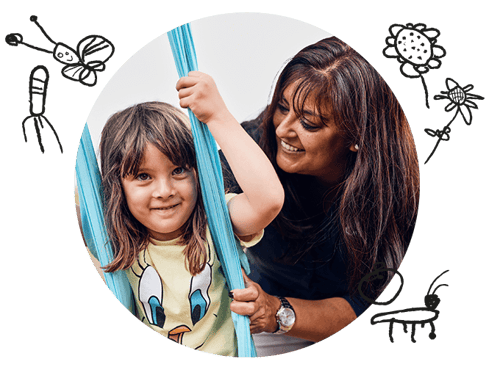stories of inclusion support

As part of our 'Stories that Shape Learning' series for the Gowrie NSW Conference, November 2024, here are are stories on how our Gowrie NSW Inclusion Agency offers its support to services across the state.
Exclusion to Inclusion

The Initial Challenge: A Child's Experience of Rejection
Our story begins with a child’s experience with rejection rather belonging in their space. It was observed that the child was biting other children, upset during the day and was not actively engaged in play with other children. These behaviors saw educator’s shadowing the child in play situations, not being included in play with children. The child began to seek comfort from educators by crying and wanting to be picked up, but educators were discouraging this over-dependence. Their response to the child inadvertently increased his sense of rejection. The family were advised that their child’s days or hours of attendance would be reduced due to the child frequently biting peers. This is a form of exclusion.
.png?width=460&height=401&name=Untitled%20design%20-%202024-09-17T164846.898%20(1).png)
Seeking Support: The Role of the Inclusion Professional
In response to these challenges, the service sought assistance from their Inclusion Professional (IP). The IP visited the care environment, engaging in reflective conversations with educators. These discussions emphasised the impact of cultural backgrounds and caregiving approaches on a child's expectations and responses to routines, self-help skills, and play.
.png?width=460&height=381&name=Untitled%20design%20-%202024-09-17T164554.510%20(1).png)
Reflective Practice: Embracing Cultural Understanding
Educators were encouraged to reflect on and deepen their understanding of cultural contexts. They began to reassess their expectations and practices, viewing behaviour through a cultural lens. This shift led to collaborative conversations with the family about home practices, including mealtimes, sleep routines, and support for play and social skills.

Positive Outcomes: Fostering Inclusive Practices
The story concludes with positive outcomes for inclusive practices at Gowrie NSW. Through critical reflection and changes in their approach, educators supported the child in becoming a leader within their peer group. The child now actively participates in the program, leading play and engaging with peers, demonstrating the nurturing and innovative spirit of Gowrie NSW.
Specialist Equipment Achieves Inclusive Outcomes
Gowrie NSW's commitment to quality education and inclusive community services shines through in this journey, highlighting the organisation's dedication to creating supportive environments for all children.
.png?width=480&height=416&name=Untitled%20design%20-%202024-09-17T164235.239%20(1).png)
Our Inclusion Story
At Gowrie NSW, our journey towards inclusion began with a challenge: a family was informed that their child, affected by Cerebral Palsy, might not be able to attend our centre due to mobility and standing difficulties. This situation highlighted the need for innovative solutions to ensure every child can participate fully in our programs.
.png?width=470&height=449&name=Untitled%20design%20-%202024-09-17T163915.458%20(1).png)
Overcoming Barriers to Inclusion
Initially, educators faced uncertainty about facilitating the child's movement throughout the day. Despite attending the centre, the child was unintentionally excluded from play due to limited mobility, leading to social isolation and difficulty engaging with peers. Our active Strategic Inclusion Plan struggled to address these specific challenges.
.png?width=460&height=406&name=Untitled%20design%20-%202024-09-17T163058.681%20(1).png)
Innovative Solutions with Specialist Equipment
The turning point came when our Inclusion Professional (IP) recommended the introduction of specialised equipment. A dynamic standing frame was implemented, transforming the child's experience by allowing him to stand at the same level as his peers. This innovation opened up a world of social learning opportunities.

Expanding Opportunities for Engagement
With the standing frame, the child accessed a broader range of resources and activities, fostering engagement with peers. He enjoyed gardening, playing in the outdoor mud kitchen, and painting—activities previously beyond his reach. This equipment not only supported his physical needs but also enriched his social and educational experiences.

Commitment to Quality and Inclusive Education
Gowrie NSW remains dedicated to nurturing an inclusive community where every child can thrive. Our commitment to quality education, innovation, and community support ensures that all children, regardless of their challenges, have the opportunity to explore, learn, and grow in a supportive environment.
We look forward to all the future opportunities that the child will be able to have with his peers using this standing frame and any other equipment that he may require in the future. - Quote from the service
Inclusion through Collaboration
A service supported by the Inclusion Team found their educators were feeling anxious and overwhelmed by the enrolment of a child with very high support needs due to a significant physical disability.
The Director reached out to the Inclusion Agency (IA) for support with a simple statement “we want to understand Inclusion Planning”.

Reflective Questions and Community Involvement
Reflective questions were used by the Inclusion Professional (IP) to fit the many pieces of the puzzle together in relation to what Inclusion could look like & questions were asked about “Who else in the community can be involved so that wrap-around-support can be provided”. Educators started to identify who in the community also supported this child and reached out to them for support.

Specialist Equipment and Communication
Specialist Equipment from the Special Equipment Library (SEL) was discussed to ensure the equipment required for maximum participation was readily available. A speech therapist agreed to demonstrate how to use communication devices, including the Little Mack Communicator, Big Red Switch, and eye gaze, to facilitate social connection & interaction.

Ongoing Training and Support
An OT provided comprehensive training to educators on how to properly position and consider WHS precautions when dealing with the specialist equipment. Ongoing bimonthly meetings, facilitated by the IA team were decided on, to ensure staff were supported and the child’s inclusion sustained.
The child can autonomously and intentionally activate the Little Mac communicator throughout the day for various activities. She leads her peers to say their 'good mornings' and to do an 'Acknowledgement to Country' (Guba Buliyaagu) during morning group times, as well as communicates her needs and wants, such as saying, can I have a turn please.






